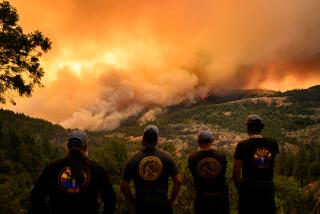In the treetops, the flames do not stall
- Share via
SOUTH LAKE TAHOE, CALIF. — Some fires race across grasslands and others burn miles of brush. But for firefighters, the most difficult are those that leap from treetop to treetop.
The blaze that has destroyed so much so quickly near Lake Tahoe is the latter, the kind known as a “crown fire” to the frustrated professionals who struggle to fight them, let alone understand them.
Crown fires can burn as hot as 1,500 degrees Fahrenheit -- so hot that water dropped on the flames from aerial tankers can evaporate before it does much good. Ravaging the forest canopy, crown fires produce cascading volumes of thick, choking smoke. In many cases, they roar along so intensely that firefighters are left with no choice but to watch.
“We could not see the sky for hours,” said Capt. Tim Allison of the Tahoe-Douglas Fire District. “It sounded like a freight train, the fire pulling in all the air.”
Capt. Brian Eagan’s California Department of Forestry and Fire Prevention crew saved a neighborhood of million-dollar homes near South Lake Tahoe. On Monday, he stood on a steep ridgeline nearby and surveyed a crest where trees had burned like matchsticks.
Towering flames had whipped across the ridge, dancing between the treetops. “They’re nothing more than standing logs now,” Eagan said.
Winds calmed on Monday, helping the legions of firefighters trying to save homes in South Lake Tahoe. .
The previous night, the winds were gusting to 35 mph and the flames were unstoppable, Allison said.
“The idea is to keep the fire out of the crowns, but with wind -- there’s nothing you can do with 200-foot flames. You run to get ahead of the line using bulldozers, natural barriers, hand tools, people. We threw it all at it.”
From the University of Nevada in Reno, Gary Zunino could see a column of brown smoke looming over Lake Tahoe, more than 50 miles away.
The director of the university’s Fire Science Academy, he was blunt about the chances for even the best-equipped crews to prevail.
“They’re virtually impossible to stop until they run out of fuel,” he said. “The big challenge is to keep the fire from getting up there in the first place.”
In the Tahoe area, conditions were ripe for a crown fire: hot days, high winds and plentiful underbrush. Some trees were tinder-dry, weakened by drought or dying from insect infestations. The plentiful ponderosa pines and Douglas firs in the region are sometimes so pitch-saturated that they “literally explode,” Zunino said.
The threat of a catastrophic blaze was so well-known in the area that the U.S. Forest Service had mounted an aggressive pre-emptive effort to thin the fuel from 38,000 acres in the Lake Tahoe Basin.
In a sense, the fire started more than a century ago. When the Comstock mining boom swept into Nevada, vast slopes in the Tahoe region were clear-cut for timber to brace tunnels and shafts and build mining towns like Virginia City. The U.S. Forest Service estimates that 90% of the area’s trees are less than a century old.
Over the years, trees were planted too close to one another, with little regard for ecological diversity. Swift fire suppression saved the forest but also allowed for volatile underbrush to accumulate over many decades.
On its website, the environmental group League to Save Lake Tahoe warned of a “high risk” of crown fire.
“It would undoubtedly devastate homes, and runoff from the scorched lands could contribute to the degradation of Tahoe’s famed clarity,” said the group, whose “Keep Tahoe Blue” bumper stickers are frequently seen around the state.
Elsewhere, crown fires have been as vexing and unpredictable as they’ve been in California. In Canada’s Northwest Territories, a team of Canadian and U.S. forest scientists deliberately set 10 crown fires to study exactly how they spread so ferociously.
“I’ve spent the better part of 30 years working to understand them,” said Marty Alexander, a scientist with the Canadian Forest Service, “and they’re still mysterious in some ways.
“We can tell you how fast they’ll spread, given certain environmental conditions,” he said. “But difficulties occur when we try to predict the impact of removing certain quantities of fuel. We simply don’t have the knowledge yet.”
Scientists know that the average crown fire travels about a mile an hour, that flames shoot into the sky at least twice as high as the trees they consume, and that the resulting wall of fire can settle on an object in its path for as long as one minute -- a lifetime in such extreme heat, Alexander said.
But even with exhausted crews carving wide firebreaks out of the woods, stopping such blazes dead is still an elusive goal. Crown fires have been known to leap across lakes.
Eagan, the California firefighter, suggested that some forces are just too big to battle.
“Sometimes Mother Nature says, ‘I’m sorry, but today I’m going to have it my way,’ ” he said.
Times staff writer Eric Bailey contributed to this report.
More to Read
Sign up for Essential California
The most important California stories and recommendations in your inbox every morning.
You may occasionally receive promotional content from the Los Angeles Times.














